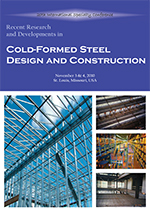Session Dates
03 Nov 2010
Abstract
In North America, the operation of buildings accounts for approximately one third of the total energy use and greenhouse gas emissions each year. Over the life of a building, the total energy use is a combination of the embodied energy in the building materials and the operating energy of the building. Building enclosures (walls and roofs) have a huge impact on both the embodied energy and the operating energy of buildings. Historically, steel has been blacklisted as a material with a high embodied energy. This has led to a misconception that steel enclosures use significantly more energy than other enclosure types. A study was conducted at the University of Waterloo to investigate cold-formed steel enclosures compared to other enclosure types in commercial buildings. After 50 years for a building located in Toronto, Canada, it was found that cold-formed steel enclosures are very competitive compared to other enclosure types in terms of total energy use and greenhouse gas emissions.
Department(s)
Civil, Architectural and Environmental Engineering
Research Center/Lab(s)
Wei-Wen Yu Center for Cold-Formed Steel Structures
Meeting Name
20th International Specialty Conference on Cold-Formed Steel Structures
Publisher
Missouri University of Science and Technology
Document Version
Final Version
Rights
© 2010 Missouri University of Science and Technology, All rights reserved.
Document Type
Article - Conference proceedings
File Type
text
Language
English
Recommended Citation
Van, K. J. and Xu, L., "A Life-cycle Assessment of Cold-formed Steel Enclosures Verses Alternative Enclosures in Commerical Buildings" (2010). CCFSS Proceedings of International Specialty Conference on Cold-Formed Steel Structures (1971 - 2018). 1.
https://scholarsmine.mst.edu/isccss/20iccfss/20iccfss-session10/1
A Life-cycle Assessment of Cold-formed Steel Enclosures Verses Alternative Enclosures in Commerical Buildings
In North America, the operation of buildings accounts for approximately one third of the total energy use and greenhouse gas emissions each year. Over the life of a building, the total energy use is a combination of the embodied energy in the building materials and the operating energy of the building. Building enclosures (walls and roofs) have a huge impact on both the embodied energy and the operating energy of buildings. Historically, steel has been blacklisted as a material with a high embodied energy. This has led to a misconception that steel enclosures use significantly more energy than other enclosure types. A study was conducted at the University of Waterloo to investigate cold-formed steel enclosures compared to other enclosure types in commercial buildings. After 50 years for a building located in Toronto, Canada, it was found that cold-formed steel enclosures are very competitive compared to other enclosure types in terms of total energy use and greenhouse gas emissions.



